
History of the Karakalpak Yurt

|
History of the Karakalpak Yurt
|
|
ContentsSummaryIntroduction Early History of the Portable Dwelling The Origin of the Trellis-Walled Yurt The Arrival of the Yurt in Central Asia The Qipchaqs and the Turkmen Yurts in the Pre-Mongol Tribes The Mongol Yurt Yurts within the Golden Horde Timurid Yurts Uzbek Yurts Qazaq Yurts Noghay Cart Tents The Karakalpak Yurt Pronunciation of Karakalpak Terms References SummaryFrom the time of the Bronze Age the cart has probably been the most widespread portable dwelling for nomads throughout the Eurasian steppes, although numerous simpler shelters were used as well. The appearance of the trellis-walled yurt was a later development that coincided with the emergence of the Turks, who subsequently introduced it to western Central Asia and to neighbouring tribes in the East.The Mongols used the ger instead of the trellis-walled yurt, a lighter dwelling with wattled walls that could be easily transported on an ox-cart. After the Mongol conquest of Central Asia, its Mongol-Turkic rulers continued to use the cart-borne ger, but the Turkic yurt was also adopted, especially by the aristocracy. During the era of the Golden Horde and in the centuries following its collapse, the numerous tribes of Qipchaq-Tatar nomads used a combination of the bow-topped cart, the Mongol cart-borne ger, and the trellis-walled yurt as they roamed the Qipchaq steppes. The Karakalpak confederation, which probably coalesced from tribes belonging to the vast Shaybanid Uzbek-Qazaq Horde in the 15th or 16th century, inherited the lattice-walled yurt and the two-wheeled cart or arba, just like their Uzbek and Qazaq neighbours. One of their traditions suggests that they might also have used the cart-borne ger as well in their early days. Unfortunately their remote location on the Jan'a Darya, far from the record-keeping centres of Khorezm, Bukhara, or Russia meant that their early history was never recorded. Our first records date from 1740, after they had been forced into the mouth of the Syr Darya by devastating Kalmuk raids, and even then we have no record of their dwellings. Further attacks by Qazaqs, coupled with the desiccation of the Syr Darya delta, pushed them further towards the Aral Delta where they were attacked, subjugated, settled, exploited, and victimized by the Khivan Khan. When the Russians arrived in 1873 the majority of Karakalpaks were destitute, only a minority having a semblance of wealth to maintain their traditional material culture. Things improved marginally under the Russians, but it was the Soviets who had the biggest impact on raising Karakalpak living standards. Karakalpak material culture flourished for a brief period in the 1920s and 1930s before falling into decline as women joined the workforce, families moved into permanent houses, and old traditions became unfashionable in the modern Communist world. Despite these changes the Karakalpak yurt and two-wheeled arba are still in use today. However their numbers are getting smaller all the time and soon they will be gone. IntroductionThe old Karakalpak yurtmakers had a legend that the very first yurt in the world was made by Ibrahim Ha'lil, a spiritual leader from holy Mecca. It was built many centuries ago on the nearby Ustyurt plateau, the hottest place in the entire region. As such Ibrahim Ha'lil became the patron of all local yurtmakers or u'yshi.The real origin of the Karakalpak yurt is far more complex and uncertain. The basic development of the trellis-walled yurt predates the formation of the Uzbek, Qazaq, and Karakalpak tribal confederations, which only occurred during the 15th and 16th centuries after the collapse of the Golden Horde. Unfortunately many of the historical records that describe yurts are biased towards the dwellings of the elite rather than the ordinary nomad – not surprising since most were composed by official scribes or ambassadors. There are many gaps, therefore, one of the most important corresponding to the opening centuries of the Karakalpak confederation.
A painting of a Karakalpak yurt in the late 1940s.
|
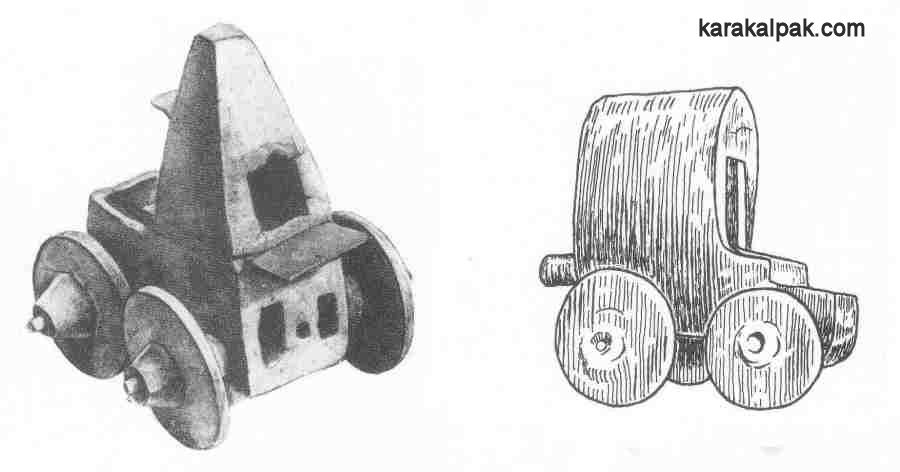
|
A description of these carts was given by Hippocrates:
"The smallest of these wagons have four wheels, but some have six; they are covered in with felt, and they are constructed in the manner of houses, some having but a single apartment, but some having three... The wagons are drawn by yokes of oxen, some of two and others of three... In these wagons the women live, but the men are carried about on horses..."while Aeschylus described them as: "...basketwork huts, high up on wheels, like waggons."
"For they have no huts ... and dwell in wagons, which they cover with rounded canopies of bark and drive over the boundless wastes. And when they come to a place rich in grass, they place their carts in a circle and feed like wild beasts. As soon as the fodder is used up, they place their cities, as we might call them, on the wagons and so convey them: in the wagons the males have intercourse with the women, and in the wagons their babes are born and reared; wagons form their permanent dwellings, and wherever they come , that place they look upon as their natural home."The first Mongol-like migrants to reach Khorezm were the Huns in the 4th century. Like the Saka, who arrived one millennium before them, they were nomads who lived on horseback and travelled with their families in covered wagons. Marcellinus left us a disparaging description of their dwellings as well:
"They are all without fixed abode, without hearth, or law, or settled mode of life, and keep roaming from place to pace, like fugatives, accompanied by the wagons in which they live; in wagons their wives weave for them their hideous garments, in wagons they cohabit with their husbands, bear children, and rear them to the age of puberty."Although Chinese reports show that the Hsiung-nu had both carts and felt-covered tents, it is not clear whether the Huns had pitched tents as well.
"They are nomads and have houses of felt. They stay for a while in one place and then move on. One can see their tents dispersed here and there all over the place according to nomadic custom. Although they lead a hard life, they behave like donkeys that have lost their way."The Chui-T'ang-shu, completed around 629, noted that they lived "in felt tents and yurts" but gave no indication of the type of yurt used.
"O lords with tents and commons of the Sir, Toquz Oghuz and Eki-Adiz!"the word used for tents being käräkü, whose primary meaning was likely to mean trellis, just like the associated word kerege today (the Turkic word ker meaning to stretch). Trellis tents were clearly associated with lords, not commoners.
"Celestial sovereign of the Black Tents,..."implying that the Kyrgyz too had the trellis tent under Turkic rule around 732.
"How is the inside of the trellis tent? How is its roof-wheel?He notes the use of the following words:
How is its trellis opening? It is open to view.
How is the curve of its dome? It is good.
How are its lashings? It has them.
Know in this way: it is extremely good."
| kerekü for trellis tent (kerege in Karakalpak and other Turkic languages including Turkmen), |
| tügünük for roof-wheel (similar to the modern Turkmen word tüynük, although in the Qipchaq
language the word is shangiraq or shan'araq), |
| kozunük for trellis opening (gozenek in Turkmen, ko'z in Karakalpak), |
| egin for shoulder or bend in the roof (egin in Turkmen, iyin in Karakalpak), |
| baghish for lashing (identical to the modern Turkmen word). |
"Beyond are the regions of paganism, the territories of the Turks, which surround Khurasan and Sistan, and which together are called Turkestan. The Turks are divided into...the Karluk, Toghuz Oghuz, Turkesh, Kimak, and the Ghuzz. ... These Turks have neither refuges at halting places nor strongholds. They only pitch Turkish domes (tents), which are ribbed and the nails are strips from the hides of pack animals and cattle, and the coverings are felt."He is clearly describing a trellis-walled yurt with the rawhide fastenings of its kerege lattice.
"...They inhabit shelters made of boards, they transport them on carts, which oxen draw..."The earliest report of a Turkic yurt in the lower Amu Darya was given by Ahmad ibn Fadlan. He endured the particularly cold winter of 921-922 in Gurganj, the capital of Kamjird in northern Khorezm. Today the ruins of Gurganj lie just outside of Kunya Urgench in Turkmenistan, just across the border from Mizdahkan in Karakalpakstan. Ibn Fadlan wrote:
"I slept in a house in which there was a Turkish felt tent (qubba lubud turkiyya); I was wrapped in clothing and furs and, in spite of that, my cheek (still) stuck to the pillow."It is likely that ibn Fadlan's yurt had been acquired from local Turkic nomads, Khorezm then being an entrepôt of the Ghuzz and the Turks, one of the major markets being at Farategin in the western part of the Aral delta. Ibn Haukal reported that the land of the Ghuzz began from the banks of Lake Khaljan, in the north-west of the delta.
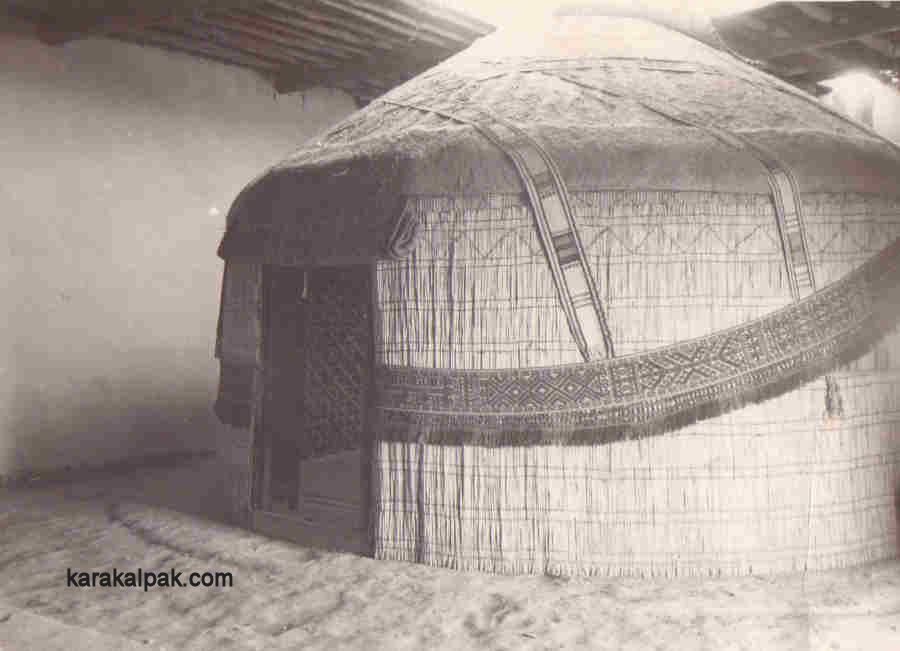
|
The Oghuz were in the process of fragmenting, their main eastern territorial stronghold at that time being along the entire lower
Syr Darya, from Sighnaq to Yangikent close to the Aral shoreline. There they maintained their nomadic lifestyle, shunning the
numerous fortified settlements along the river. Interestingly the western Ghuzz that ibn Fadlan encountered between the Ustyurt
and the Emba in the spring of 922 seem to have adopted a different lifestyle, living in "tents of hair", an ambiguous description
which could indicate tents covered with pelts or tents similar to those used by the nomads of Arabia. The Hudûd al-Âlam (982) noted
that "The Ghuz have no towns, but the people owning felt-huts are very numerous."
At the same time a very different type of nomadic culture had become established within the Aral Delta, in the region north of
present day No'kis and stretching to the Aral shoreline. Named the Kerder culture, it had been initially founded in the 7th century
by Jety Asar cattle-breeders, whose origins may go back to the Massagetae confederation. As their waterways dried up in the
lower Syr Darya they were forced to migrate southwards into the Kerder region of the Aral delta. Further waves of Jety Asar
arrived after the Arab invasion and were joined in the 9th century by some of the Pechenegs displaced by the Oghuz along the
middle Syr Darya. There is some archaeological evidence to suggest that the Jety Asar used some form of portable dwelling
before they left the Syr Darya region.
Kerder settlements generally had an irregular outline, suggesting that they developed spontaneously with the arrival of the nomads.
One of the larger settlements was at Quyuq qala, which contained two citadels dating from different periods, one of which was
surrounded by a fortress wall and ditch. The remains of numerous brick bases in the surrounding area indicates that it was
occupied by a city of yurts, although sadly there is no indication of the types of portable dwelling used. As the Kerder
canal began to dry out during the 11th century, so the Kerder community became dissipated, some nomads migrating into other
parts of Khorezm and some into the Volga region.
The Qipchaqs and the Turkmen
The Qipchaq were originally one of the seven tribes that composed the Qimek federation. After the Kyrgyz defeat of the Uyghur in
840, the Qimek moved westwards towards the steppes adjacent to the middle reaches of the river Irtysh, and perhaps the Ob.
Ibn Xurdâdhbih wrote in about 875:
"As concerns the King of the Kimek, he changes his tents according to the grazing land."The anonymous author of the Hudûd al-Âlam (982) described the territory of the Qimek as possessing “only one town but many tribes”. The Qimek:
"...live in felt-huts and both in summer and winter wander along the grazing grounds, waters, and meadows. Their commodities are sable-martens and sheep."The separation of the Qipchaq from the Qimek seems to have been in some way associated with the movement of an Altaic tribe known as the Qun. The Qun were attacked by the Qay and were forced to invade the lands of the Sari, who might have been a part of the Qipchaq. Some say the Qun and the Qipchaq are one and the same, hence the alternative name Quman. Having separated from the Qimek, the Qipchaqs moved to the south-west, settling close to the border with the Pechenegs. By the 1030s the Qipchaqs and allied tribes of Chughraq (or Yigraq) and Küchet were already harassing the borders of Khorezm.
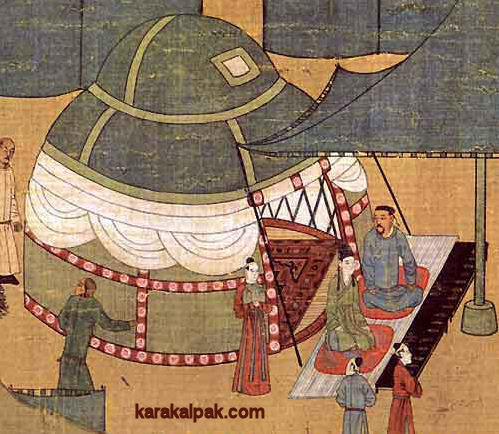
|
Three of the paintings show that the Khitan were using two types of trellis-walled yurts at this time:
| a small and simple, low-status yurt with a slightly curved conical roof and a rounded top, and |
| a larger, high-status blue-coloured yurt with arched roof struts and a pronounced dome-shaped roof-wheel, with a diameter about half that of the yurt itself. |
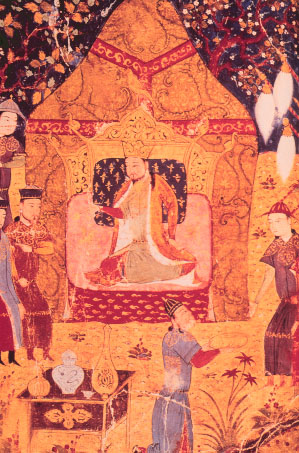
|
The ger was not collapsible and had to be transported on a cart, hence the ger tergen. The Mongols also used covered carts,
which were an essential element of the mobile military camp. Referred to as tergen or qara'utai tergen, they were driven
by the women and transported the household goods. They had two wheels, two shafts, and were pulled by oxen. When a Mongol army struck camp,
the tergen were either aligned in rows or used to create a defensive circle.
One complicating factor arises from a report from two Chinese ambassadors, P'eng Ta-ya and Hsu T'ing, who traversed the Mongol
steppes in 1236 and observed non-collapsible dwellings on carts. However in Yen-ching (Beijing) they also saw dwellings whose
framework could be rolled up and unrolled, which were made from willow twigs being similar to a sieve, had a top similar to the
framework of an umbrella, a top opening, and a covering of felt.
The suspicion is that these trellis-walled yurts were of Khitan origin. Although the Khitan Empire broke up in 1125 many of
its tribesmen joined the Jürchen under the succeeding Chin dynasty. When the Mongols invaded northern China in 1212 they
encountered Khitan units within the Jürchen, who allied themselves with the Mongols. Since Yen-ching was the southern capital
of the Khitan it is possible yurt manufacture was maintained in local workshops over this period.
The first specific reference to the Mongol use of a trellis-walled tent is provided by Juvaini in relation to Ögedey Khan (1229-41)
at Qaraqorum. The Khan would often go into the mountains in the summer:
"…where there would be erected for him a Khitayan pavilion, whose walls were made of latticed wood, while its ceiling was of gold-embroidered cloth, and it was covered all over with white felt: it is called Sira Ordo."This was not a yurt but a royal pavilion, capable of holding a thousand people.
"Their dwelling-places are round like tents and are made of twigs and slender sticks. At the top in the middle there is a round opening which lets in the light, and is also to enable the smoke to escape, for they always make the fire in the middle. Both the sides and the roof are covered with felt, and the doors are also made of felt. Some of these dwellings are large, others small, according to the importance or significance of the people; some can be speedily taken down and put up again and are carried on baggage animals; others cannot be taken down but are moved on carts. To carry them on a cart, for the smaller ones one ox is sufficient, for the larger ones three, four or even more according to the size. Wherever they go, be it to war on anywhere else, they always take their dwellings with them."This suggests the use of both collapsible Turkic yurts and non-collapsible Mongol ger and ger tergen.
"The dwelling in which they sleep is based on a hoop of interlaced branches, and its supports are made of branches, converging at the top around a small hoop, from which projects a neck like a chimney. They cover it with white felt: quite often they also smear the felt with chalk or white clay and ground bones to make it gleam whiter, or sometimes they blacken it. And they decorate the felt around the neck at the top with various fine designs. Similarly they hang up in front of the entrance felt patchwork in various patterns: they sew onto one piece others of different colours to make vines, trees, birds and animals. These dwellings are constructed of such a size as to be on occasions thirty feet (9 metres) across: I myself once measured a breadth of twenty feet (6 metres) between the wheel tracks of a wagon, and when the dwelling was on the wagon it protruded beyond the wheels by at least five feet on either side. I have counted twenty-two oxen to one wagon, hauling along a dwelling, eleven in a row, corresponding to the width of the wagon, and another eleven in front of them. The wagon's axle was as large as a ship's mast, and one man stood at the entrance to the dwelling on top of the wagon, driving the oxen."Other observers have recorded that the tent frames were made from willow.
"Their huts or tents are formed of rods covered with felt, and being exactly round, and nicely put together, they can gather them into one bundle, and make them up as packages, which they carry along with them on their migrations, upon a sort of cart with four wheels. When they have occassion to set them up again, they always make the entrance front to the south. Besides these cars they have a superior kind of vehicle upon two wheels, covered likewise with black felt, and so effectually to protect those within it from wet, during a whole day of rain. These are drawn by oxen and camels, and serve to convey their wives and children, their utensils, and such provisions as they require."
"The place where we landed was in the wilderness known as Dasht-i-Qifjaq. ...There is no means of travelling in this desert except in wagons, and it extends for six months journey, three of them in the territories of the Sultan Muhammad Uzbak, ...one of the merchants in our company went to some of the tribesmen known as Qifjaq ... and hired from them a wagon drawn by horses."Some days later, ibn Battuta purchased his own cart, eating, sleeping, and writing as he travelled:
"They are wagons with four large wheels, some of them are drawn by two horses, and some drawn by more than two, and they are drawn also by oxen and camels, according to the weight or lightness of the wagon. ...There is placed upon the wagon a kind of cupola made of wooden laths tied together with thin strips of hide; this is light to carry, and covered with felt or blanket cloth, and in it there are grilled windows."On reaching Bish Dagh, ibn Battuta set his camp on a low hill just in time to witness the arrival of Õzbeg Khan's ordu:
"...we saw a vast city on the move with its inhabitants, with mosques and bazaars in it, the smoke of the kitchens rising in the air (for they cook while on the march), and horse drawn wagons transporting the people. On reaching the camping place they took down the tents from the wagons and set them on the ground, for they are light to carry, and so likewise they did with the mosque and shops."When Timur's army attacked Toktamish and his White Horde near Samara between the Volga and the Ural rivers in 1391, Sharaf al-Din Ali Yazdi reported:
"...the dwelling of the plainsmen in that endless desert is the portable tent (khargah-i kutarma), which is built in such a way that it cannot be taken apart; and they construct it as though it were pitched, and lift it up, and when they move or migrate they place it upon a cart and go on their way..."Toktamish used his army's carts, probably high two-wheeled carts, as defensive shields.
"...it was not supported by guy ropes, and it was round, and the walls were of rods about as thick as lances, which were placed crosswise like a net, and above these rods there was something like a tall dome, also made of very tall rods, and this dome and the walls of the tent were fastened one to the other with belts as broad as a hand, and they came down below and were fastened to some stakes set next to the walls of the tent ... on the outside it was girded around the middle by some white bands which went crosswise, which passed all around ... it had a tall doorway with doors made of very small canes covered with coloured material..."Andrews has conjectured that these royal yurts were of Chaghatay origin and had double trellis walls (one on top of the other). The door was clearly made of shiy.
"The aq üy is a conspicuous subject, to which they have put the name khargah, but for most of its parts they use the Turk language. Thus they say tünglük, and üzük, and turlugh, and basrugh, and chigh, and qanat, and közenek, and ugh and baghish, and bosaga, and erkene, and so forth ..."He lists the roof-wheel, roof felt, wall felt, shiy, trellis, uwıq, lashing, and threshold of a yurt. The meaning of basrugh is not clear, while erkine might be a folding door.
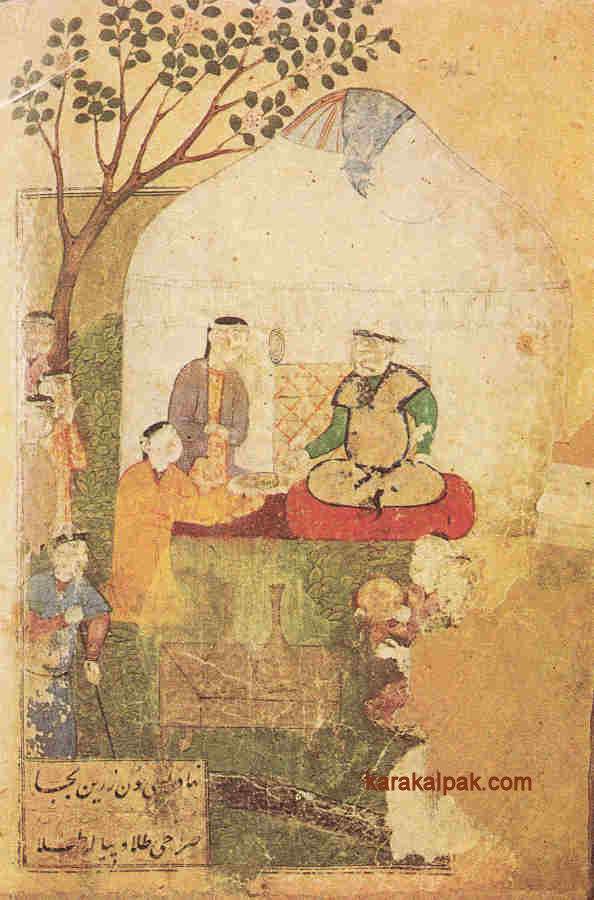
|
By the time the English Elizabethan former sea captain named Anthony Jenkinson visited Central Asia in 1558, the branch of the
Shaybanid family ruling Khorezm (the Arabshahids) had descended into banditry, and the region was fraught with danger. Landing
on the Mangishlaq coast, Jenkinson's party hired camels in order to travel to Vazir, the capital of Khorezm at that particular time.
Jenkinson observed that the region in between the Caspian shore and Vazir was devoid of habitation apart from nomads "in great
companies" roaming with large numbers of cattle and other livestock. Sadly he failed to describe any of their dwellings.
Within five days the camel train was intercepted by well-armed Tartars and servants of Timur Sultan, the Uzbek governor of Mangishlaq
and brother of Hajjim Khan, the overall ruler of Khorezm. Jenkinson decided it would be wise to seek permission for his travels from
Timur Sultan and was entertained by him in:
"a little rounde house made of reedes covered without with felt and within with Carpets."This is the earliest record we have concerning the use of reed screens in the lands under Khorezmian control.
"...for the Uzbeks hang along the sides small carpets of home manufacture; and though the work be coarse, and the colours generally of a sombre hue, dark red or brick colour in particular, their presence sets off the tent to advantage, and gives it an appearance of cleanliness."
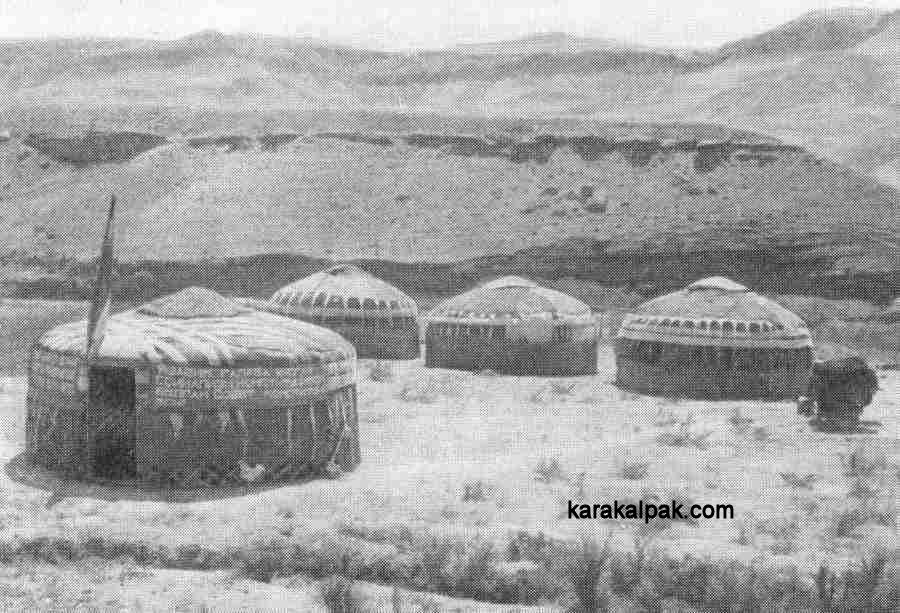
|
Qazaq Yurts
Some of the Qazaqs, remnants of the White Horde, were led westward by Kirey and Jani Beg in the mid-1460s, establishing their
headquarters at Yasi, the modern day city of Turkestan. In 1506 Shaybani Khan attacked these Qazaqs, who were led by Jani Beg's
son Janesh. Ibn Ruzbihan, a man not prone to exaggeration, saw the dwellings that were captured in this raid and left us a
detailed report:
"They plundered ... in excess of ten thousand Kazakh homes which were bound on carts, and the carts harnessed to camels, and took them from the battlefield. What homes! Palaces raised in the air and homes built of wood in the open steppe of the world! Beams and boards of poplar in complete firmness and proportion and art and full ornament wrought all around, and felts of many colours, with outlandish designs and strapwork incised with perfect delicacy and art. The basis of the erection of each tent was brought to the shape of a heavenly dome. Those which were the homes and dwellings of the great men and princes among them appeared as elegant trellis tents, each of which could worthily accommodate twenty people or more if sitting comfortably and at ease."He went on to describe a second, more common type of home:
"There were other houses, khana-ha, of the rest of the people made long in shape, and adorned with art and complete delicacy, and harnessed to one camel or more, and there were small doors provided in front of and behind each house so that its inhabitants might look about ..."In September 1770 Johann Peter Falk, the Swedish botanist, and his colleagues Johann Georgi and Christoph Bardanes visited the temporary camp of Sultan Nur Ali, the grandson of the Khan of the Lesser Horde Abu'l Khayr. It was located on the Ural River close to Orenburg, and consisted of about 20 yurts. Naturally the Qazaq prince's yurt was the largest and was covered in white felt. Its interior was covered with carpets and pillows, bows, guns, sabres, and saddles hung from the walls and the Sultan's sleeping quarters were surrounded with silk curtains. In July 1771 Falk and Bardanes visited the headquarters of Sultan Mamet, Khan of the Middle Horde. His awıl had only eight yurts, three of which were covered in white felt. The latter were reserved for the use of the Khan and his family. The Khan's own yurt was large, and had a cauldron of meat and groats cooking over the central fireplace. It was simply furnished with a "Persian" carpet and a small box surmounted by a leather bag containing clothing.
"The dwelling of the Kirghiz is a kibitka or yurt, i.e. a half-spherical tent, made up of a wood lattice covered with felt, and provided at its higher part with a large round opening, which can be opened and closed at will. It acts as a window, and takes the place of a chimney when they light a fire in the tent. These tents, which are very similar to those of the Kalmuks, are from four to eight arshins high, and eight to fifteen arshins in diameter. At some agreed and dedicated site, they attach the lattice wall by means of cords of hair. The doors are made of wood and are furnished with ornaments in small bone, with which they are encrusted; sometimes a simple felt takes the place of a door. The cords, which are used to bind and maintain the lattice, are generally made of wool, and for a rich person, out of silk. In summer the interior walls are covered by a type of curtain braided with straw and variously coloured threads. During the hot summer days they raise the felts at the bottom: these curtains let the fresh air penetrate and protect the interior of the tent from the dust and the heat of the sun. The tents of the common people are made of grey felt; those of the high and mighty and the rich, of white felt; and some sultans, belonging to the more powerful Middle and Great Hordes, cover theirs with red cloth on the outside and with silk fabrics on the inside. The poorest, on the contrary, substitute the felts with mats of tree bark or leaves, and sometimes they even use reeds and turf.Levchine added that a Qazaq aul or village rarely contained more than 50 or 60 yurts, since the pasturage could not support any larger numbers. Usually the inhabitants of such auls were all related.
The bottom of the tent, opposite the door, is occupied by trunks covered with carpets, which are used to store the clothes, the overcoats and other clothing. From the walls they hang rifles, sabres, bows, arrows, saddles, horse harness, gunpowder, etc as well as hand towels, teapots, jugs, toursouks (types of leather bags), and also frequently pieces of smoked horse meat. The earth, which is used as a floor, is covered with carpet or felts. On these carpets they arrange large pots, cauldrons, the wooden beds on which they place pillows, and particular kinds of chests, which are decorated in various manners. They are used as places for the bags that contain the qumis.
A Kirghiz removes and replaces his tent in half-an-hour, and he unceasingly transports it, on the back of a camel, to those places where he finds good pasture and water for his herds. He depends on his herds and livestock breeding above anything else."
"The yourt was formed of willow trellis-work, put together with untanned strips of skin, made into compartments which fold up. It was a circle of thirty-four feet in diameter, five feet high to the springing of the dome, and twelve feet in the centre. This dome is formed of bent rods of willow, one and a quarter inch diameter, put into the mortice-holes of a ring about four feet across, which secures the top of the dome, admits light, and lets out the smoke. The lower ends of the willow rods are tied with leathern thongs to the top of the trellis-work at the sides, which renders it quite strong and secure. The whole is then covered with large sheets of voilok, made of wool and camel's hair, fitting close, making it water-tight and warm. A small aperture in the trellis-work forms a doorway, over which a piece of voilok hangs down and closes it; but in the daytime this is rolled up and secured on the top of the yourt."
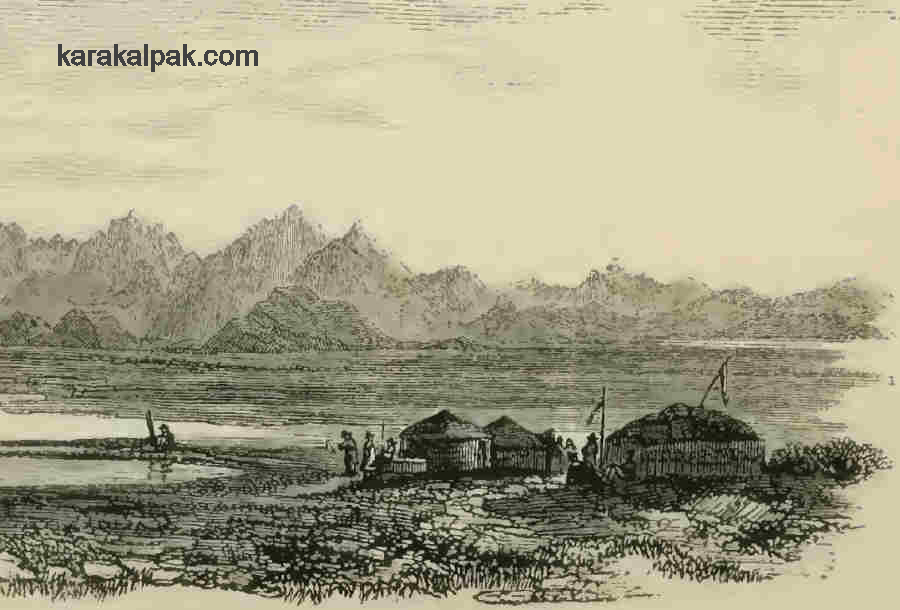
|
In 1865 A. K. Geyns, a member of the Steppe Commission, visited the rural district of Andagul-Oraz-Baimbetov in Kokchetav region and found that
almost all of its inhabitants were occupied by the production of kerege yurts. He estimated that there were approximately one thousand
yurts available for sale. At the village of Chingisa Valikhanova close to Airtavskoy he visited a large and stunning Qazaq yurt, built with
ten unpainted qanats and arched uwıqs. It was covered with white embroidered felts, its walls were wrapped with
shiy mats braided in wool, and the door was made from a red quilted cloth edged with Chinese material. Local people described two other
types of yurt in the region at that time:
| - the light-weight kos or dzhukum u'y, designed to be carried by horse-herders, which had two qanats, no roof wheel, and straight uwıqs, and |
| - the Kalmuk yurt, which had longer and straighter uwıqs and a relatively smaller shan'araq. |
"This frame is easily taken apart and put together, and is so light as to form a load for a single camel only. The broad pieces of felt are easily stretched over it, so that the whole can be put up in about ten minutes. On one side is a door covered by a flap of felt, and the fire is built in the middle, the smoke escaping through an opening in the roof. The interior of the tent is decorated with pieces of ribbon of various kinds, used to fasten down the felt, and around the sides the Kirghiz [Qazaqs] place and hang all their valuable goods, consisting of carpets, silk matresses, and clothes, and sometimes, in cases of the richer men, of even silver articles, with the trappings of horses and household utensils. The kibitka forms a most comfortable abode, being cool in summer and warm in the winter."Schuyler was accompanied at the start of his trip by Januarius MacGahan, a young American journalist working for the New York Herald, who was hoping to cover the Russian invasion of Khiva. At Fort Perovsky Schuyler continued on toward Tashkent, following the route of the Syr Darya, while MacGahan headed south to cross the Qizil Qum, initially following the course of the Jan'a Darya to the east of the Aral Sea. For the next month he travelled with his guide through the pasturelands of the Qazaqs of the Lesser Horde, "travelling with them, eating with them, and sleeping in their tents." However the first nomads he encountered were Karakalpaks, who seemed to be following a half-Karakalpak, half-Qazaq life-style. As a consequence, the yurt camp that he describes in his travelogue appears to be Karakalpak not Qazaq (see below). However his book is illustrated with Qazaq yurts engraved by the Russian military artist Vasiliy Vereshchagin, who accompanied General Kaufmann on his Khiva campaign:
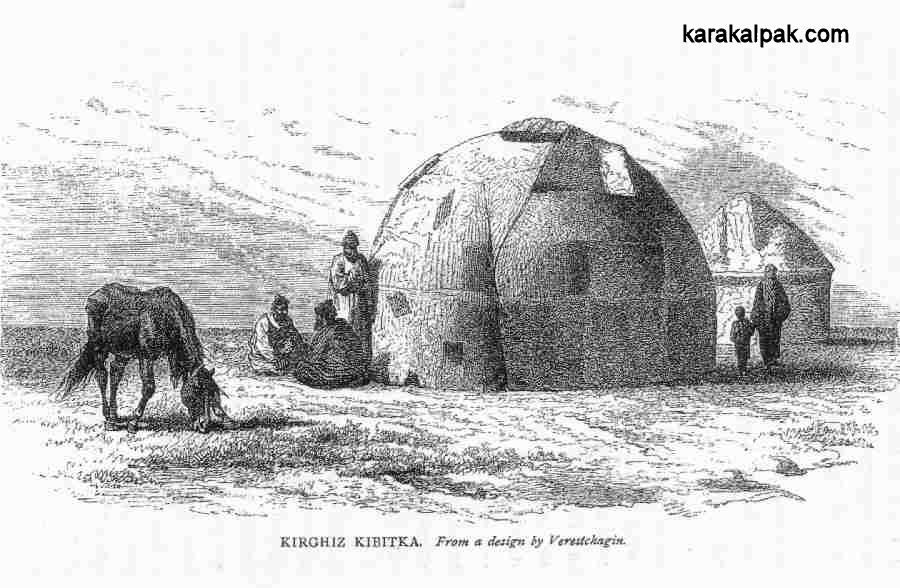
|
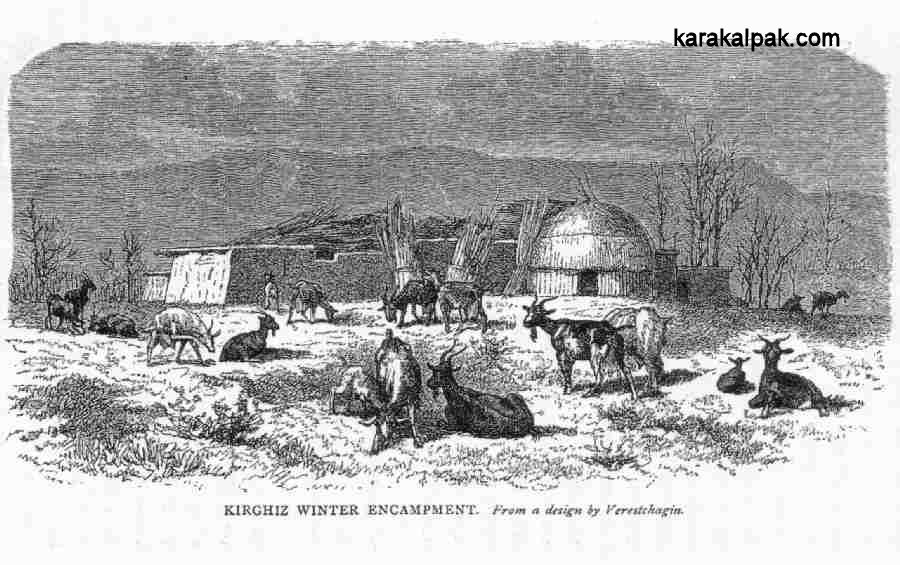
|
Henry Lansdell made a similar trip to Schuyler in 1874 and while in Vierny (now Almaty) he arranged to visit a Qazaq aul at Suigati. Luckily he witnessed the erction of a yurt and was able to take notes:
"The component parts of the kibitka are felt and matting, wherewith to cover a framework that consists of a lintel and side-posts for a door, and pieces of trellis-work (called kiriga, as I took down the name phonetically from the woman's mouth) resemble a pair of lazy-tongs, or, better still, an English child's toy on which he moves his little company of soldiers, the wooden lathes or poles forming a trellis being fastened with a leather thong where they cross. Four of these kiriga, tied together and expanded so as to stand about 4 feet high, made with the doorway, a circle about 6 paces in diameter, and the whole was girded by a broad band of worsted. Then was hoisted, perhaps 9 feet high, over the centre, a wooden hoop, called chunrukh, to serve as chimney, ventilator, and window, into the holes of which were thrust the ends of long wooden staves called ookh, the other ends being tied to the trellis work, so that, when the woman had tied 55 of these ookh, the framework of her small tent was ready. Huge pieces of felt were then hoisted to the top on poles, and drawn to their position by two bands called bau, and afterwards fastened; the covering for the doorway being hung from the lintel like a curtain. The felts did not quite reach the ground, fresh air on this occasion being a desideratum; but there were placed on the grass two pieces of reed matting called tchi, fastened inside and encircling the tent to the height perhaps of 4 feet, a binding line being tied round to keep all taut. Besides this, ropes made of horse's manes hung from the hoop or corona inside to keep the tent down, and outside a stake was driven into the ground to windward for similar security. The floor was strewn with felts, a space being left in the centre for the fire."
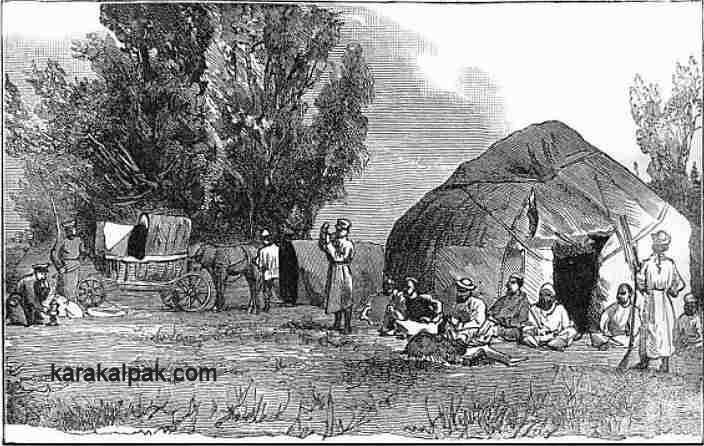
|
He was told that such a small yurt would cost £2.50 new, and a normal sized yurt would be £5. Lansdell also visited a very large yurt owned by a
wealthy Qazaq judge, valued for comparison at £100. It was 12 feet tall, 9 paces in diameter, had 120 roof poles, its felt was lined with silk, and
the walls and floor were covered with carpets. He then travelled to a neighbouring aul to visit some inhabited yurts. The trellis walls
were hung with "basins, bags, harness, firearms, leather bottles, skins, clothes, and a Kalmuk bass, or box in which to put cups and basins,
to be slung on the back of a camel". There were rolls of felt, cushions, carpets, and trunks full of possessions, including a Russian metal box. In
the centre was a huge open cooking pot, surrounded by metal ewers and leather pails, some with a spout.
The Scottish politician Henry Alexander Munro-Butler-Johnstone also visited some Qazaq yurts on the eastern banks of the Volga in the late summer of
1874 and left us a vivid description of his findings:
"A Kirghise encampment is a picturesque sight. The orientally grave and sedate camel gives it too an air of reality. The tents are oval-shaped, like bee-hives, with a hole at the top, serving indifferently as a window or a chimney. This is covered up, if necessary, by a piece of felt, with which material the whole tent is covered. The framework of the tent is composed of birch twigs of the thickness of a little finger, and presents, when stripped of its felt covering, very much the appearance, on a large scale, of those cages or crinolines one sees dangling in the windows of a provincial shop. This wooden framework, as well as the felt covering, takes into four or five pieces, and is packed, together with the women and furniture, on the backs of the camels, the men following some hours afterwards on horseback, when the encampment strikes its tents and moves to other quarters: when necessary, this demenagement takes place in an incredibly short space of time; five minutes is as much as is required to pack up and be on the way."
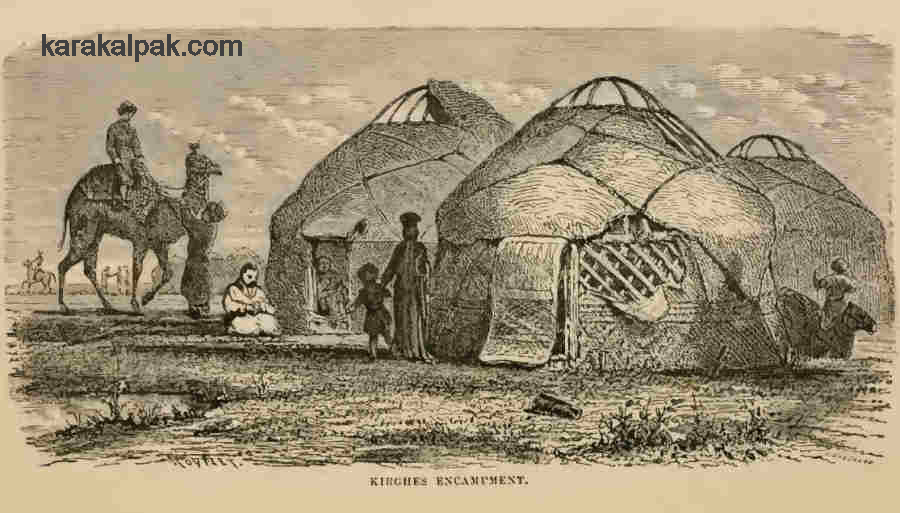
|
"The tent door consists of an opening at the side, at the top of which a rush matting is rolled up and let down when necessary. One's first impression on entering a tent is an impression of grimy gaudiness, the exact opposite of the simplex munditiis of Horace: everything in it is of red and flaring colours; small carpets or mats of bright Persian pattern are thrown about the ground; on them are strewn cushions of various sizes covered with similarly-coloured cotton prints; a curtain of similar material and design divides off a segment of the tent — that apportioned to the women. Although his creed admits of a plurality of wives, the wise Kirghis does not venture on the experiment within the precincts of his tent. Fancy the consequences, if he did! From the roof, so to speak, of the tent — that is, from its upper concave sides — are occasionally suspended bright red and yellow ribbons, like the pennants of banners. The Kirghis by no means despises ornamentation, only he has his own ideas about ornamentation. A chest or wooden box, painted red, and relieved with yellow birds or griffins, completes the inventory of a tent; in this box are packed the more valuable goods, such as the women's ornaments, as well as their crockery and other implements of domesticity. A Kirghis tent always contains this coffre fort. No description, however, would convey a faithful picture of the interior of these tents which omitted to give to it its last touch of colouring. This consists of a strong coating of nomad dust and soot; which is by no means remarkable, considering that the fireplace is constructed by a few stones piled in the centre, from which the smoke is allowed to wend its way as it listeth to the little aperture which I have described at the top of the tent. An inevitable consequence of this is that great numbers of the Kirghes suffer from sore eyes: ..."
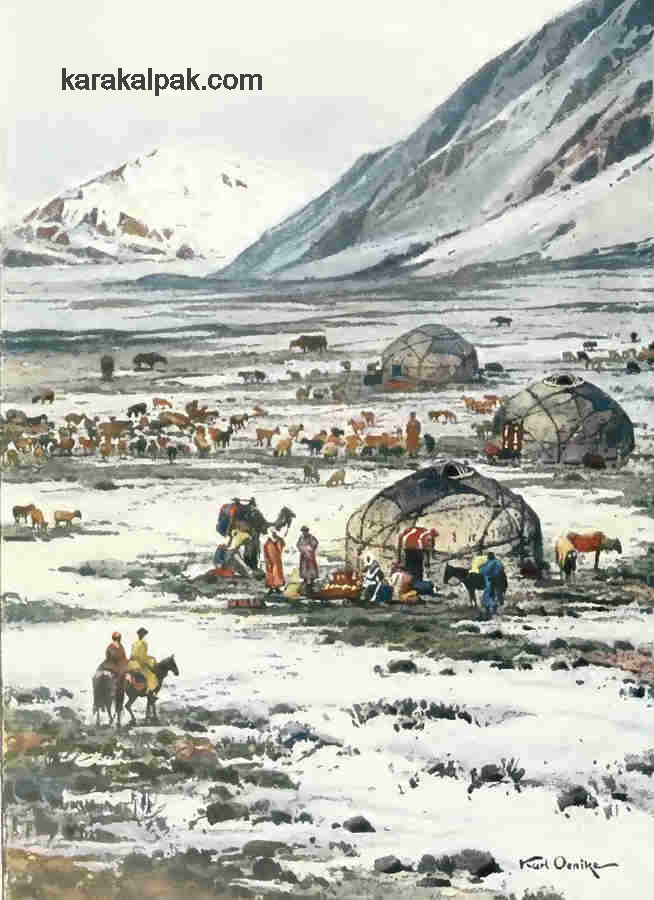
|
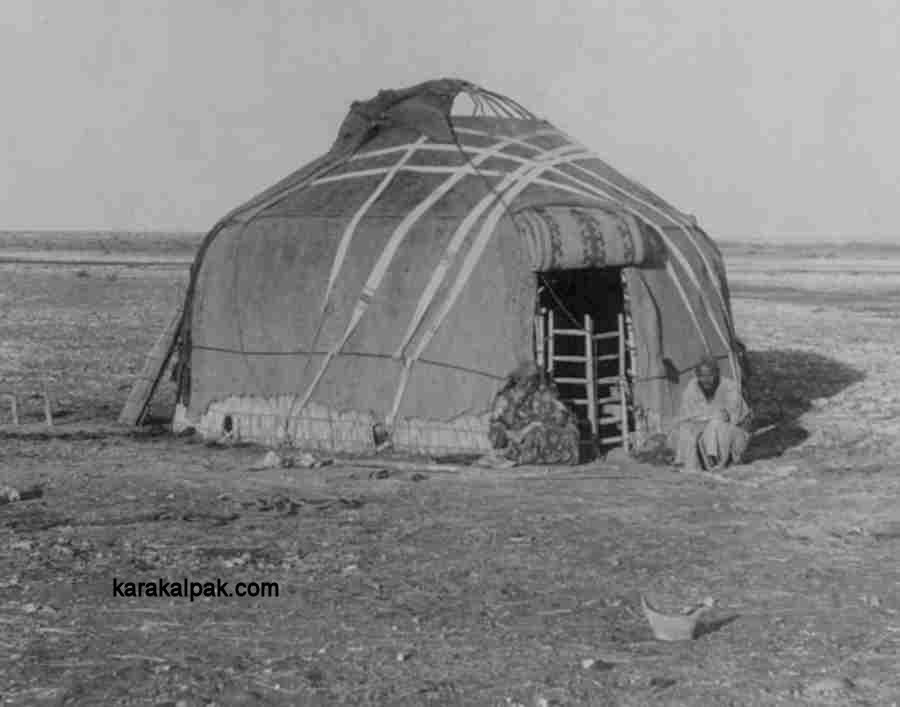
|
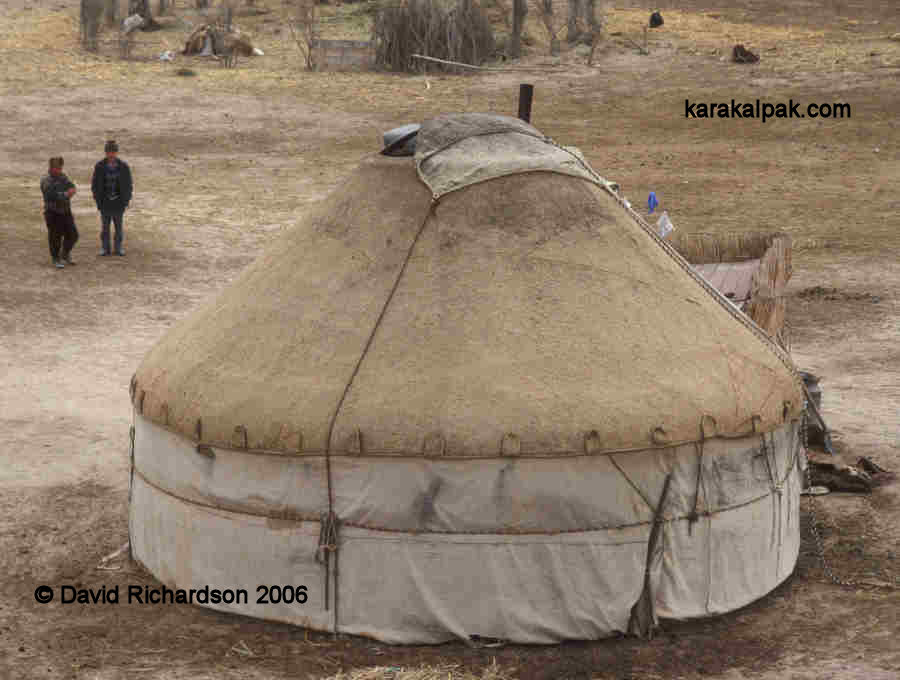
|
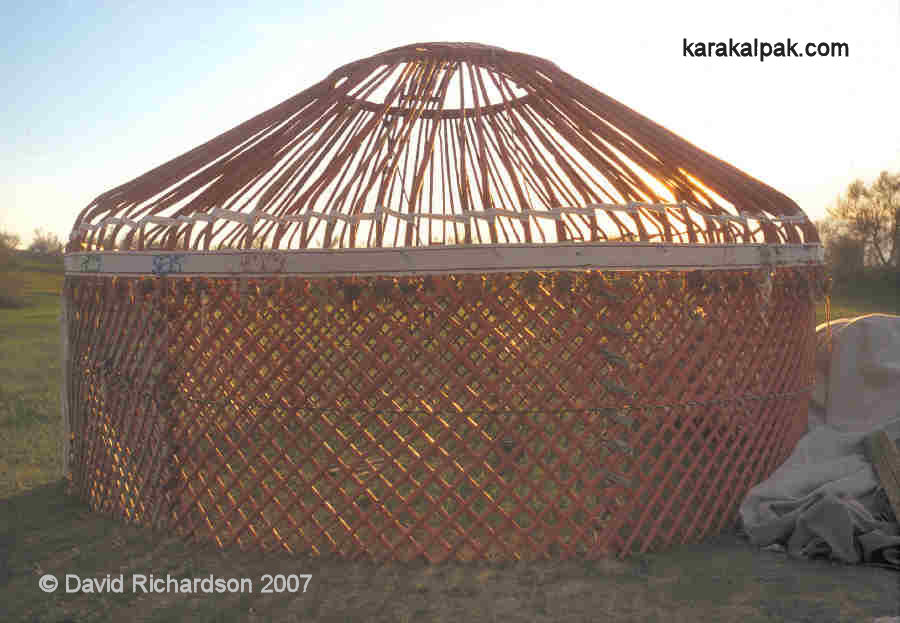
|
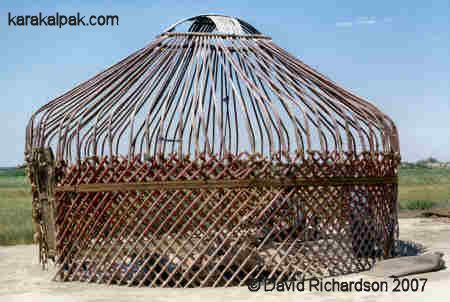
|
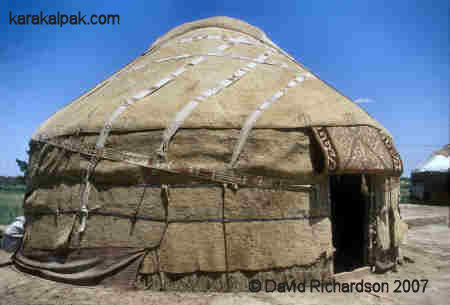
|
Noghay Cart Tents
The Noghay Horde, named after the powerful late 13th century army commander of the Golden Horde, Noghay Khan, was a remnant of the
Golden Horde and occupied the steppes north of the Black and Caspian Seas. In the first half of the 1500s Munster and Gastaldus
mentioned several Tartar tribes living to the east of Moscovia, including the Noghay. They wrote that:
"All the Tartars whiche inhabite towarde the east beyonde the ryuer of Volga, haue no dwellyng places, nor yet cities or Castles, but cary about with them certayne cartes or wagens coured with beastes hydes, vnder whiche they reste, as we do in our houses. They remoue together in great companyes, whiche they call Hordas. They are warlyke people, and good horsemen, and are all Macometistes [Mahometans]."When Jenkinson sailed down the Volga in 1558 the Noghay had been weakened by a series of events: numerous wars with the Russians, a plague, and a civil war. South of Perevolog, Jenkinson observed one of the Noghay Hordes:
"...pasturing ... by estimation about a thousand cammels drawing of carts with houses upon them like tentes, of a strange fashion, seeming to be a farre off a towne ..."
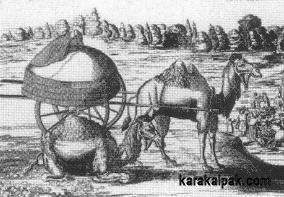
|
Adam Olearius visited Astrakhan in 1636 and recorded the Noghay tent cart in words and pictures. The tents were round, three
metres in diameter, made from twisted reeds or stems, with a felt roof and a central smoke hole. They looked like hen coops.
In the cold weather they surrounded the outside with felt and heated it with a fire of burning branches and cow dung. The
detailed drawing of a similar Tatar tent cart from the Ukraine was executed at about the same time by a French artillery engineer
named Guillaume Le Vasseur. It shows the tent was indeed built like a hen coop with cylindrical walls and a hemispherical top.
It was constructed from twenty vertical struts and eight horizontal hoops, the highest hoop being the roof wheel.
Cornelius Le Brun made similar observations when he visited the Tartars just outside of Astrakhan in 1703. He described the cart tent
in some detail:
"Their tents are made much like Parrot Cages, except that they are not so high in proportion; they are composed of Lathes four or five inches thick, and covered with Felt, Camel or Horse hair. Those of the most considerable Persons among them, are covered in Cloth; they all have an opening at the Top to let the Smoke out, with a Pole in the middle, which reaches out four or five Foot: to the end of that Pole they fix a Piece of Cloth of divers Colours, which comes down to the Ground, and hangs on a broad Strop which they fasten on the outside of the Tent; by the Help of which they turn the Cloth which way they please, to keep the Wind or the Heat of the Sun. When all of the Smoke is gone out, they cover the Top, and then their Tents are as warm as a Stove; the Bottom or Floor of it is laid with fine Stuffs or handsome Carpets according to the Rank of the Owners, with a Sofa after the Turkish fashion, raised a little above the Floor, which takes up one third part of the Tent. They also have in them very fine Trunks to lock up things of Value, and in general all is very clean and in good Order. When they remove, they put their Tents up on Waggons after having taken off the Cover. The Women and Children put themselves into them, and the Men accompany them on Horseback."The most interesting insight into this region comes from three slightly later visits by German observers - in 1769, 1773, and 1793-4 respectively. The first two visits encountered non-collapsible cart tents made with a light wooden frame, covered with rushes and reeds or rush mats and outer coverings of felt. Johann Georgi noted that they could be round, hexagonal, or octagonal and were quite small. For transportation the tents were lifted up high onto a wheeled cart, the top of the wheels being hidden by the tent walls. When the nomads were migrating and spending only a few days in one place they often left the tent on top of the cart. The third and later expedition to the region, however, encountered trellis-walled yurts adopted from Qazaq nomads of the Inner Horde who had recently began wintering in that region. The latter dwellings were used for receiving visitors, while the cart tent remained the primary dwelling for the women and the household goods. The expedition artist engraved a plate that superbly illustrates the three types of dwelling used by this Noghay tribe: the bow-topped cart, the cart tent or cart ger, and the trellis-walled yurt.
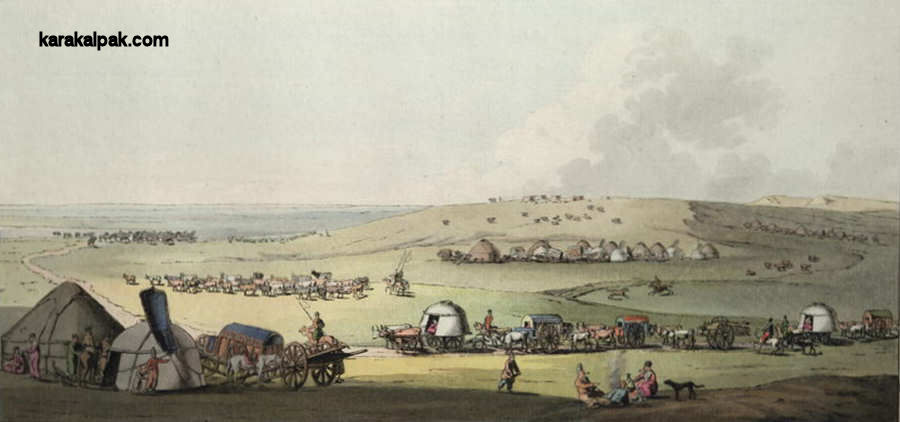
|
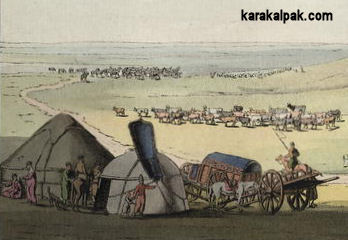
|
Karakalpak Yurts
We have no idea whether the early Karakalpaks used a cart tent like the 16th century Noghay or Qazaqs. The only hint that they
might have comes from an old Karakalpak custom, re-enacted during festivals and reported by Anna Morozova. A yurt would be placed
upon a platform, supported by three arba – one arba at the front yoked to a horse and two behind, thus creating
a six-wheeled vehicle. This moving "theatre" would be occupied by actors and musicians as it was pulled through the cheering crowd
to its assigned location.
The first historical account of the Karakalpaks occurs in a deed to the mausoleum at Sighnaq, issued by the Khan of Bukhara in 1598.
The deed simply mentions that the Karakalpaks were one of the "nomadic tribes" living in the area.
Munis recorded the historical incursions of Karakalpaks from the Jan'a Darya into the Aral Delta to support the uprisings of the
Aral Uzbeks in the early 1700s but provided no description of their yurts, which were simply called dwellings, or öylär in Chaghatay.
The Scottish traveller John Bell was told about the Karakalpaks living to the east of the Volga when he visited Samara in 1716.
Their constant raiding posed a threat to the town. Indeed a group of two to three thousand Karakalpaks set up camp three miles from
the town during his visit and the local people had to carefully guard their cattle. He noted that the Karakalpaks "live always in
tents, with their flocks, removing from place to place, as led by inclination or necessity".
We have to wait until 1740 before our first detailed description of the Karakalpaks, although even this makes no mention of
their yurts. Lieutenant Dmitry Gladyshev and his surveyor Ivan Muravin led an expedition to visit Ilbars Khan in Khiva, visiting
the Khan of the Qazaq Lesser Horde, Abu'l Khayr (1717-1748) on the way. The Karakalpaks and their Qazaq overlords had been
seeking closer ties with Russia for some time, aware of impending danger from the warlike Jungars to their east. During the
1720s both the Qazaqs and the Karakalpaks based along the Syr Darya came under devastating Jungar attack, which led to a major
dispersal of their different tribal groups. The lower Karakalpaks were forced westwards towards the mouth of the Syr Darya.
In 1740 Abu'l Khayr was encamped at a Karakalpak settlement on a promontory located on the north-eastern coast of the Aral Sea
between the Syr Darya and the Quwan Darya. The Karakalpaks were mainly settled along the Adam-ata tributary of the Quwan Darya
and on the large island of Yangikent, facing the mouth of the Syr Darya. There they raised cattle, cutting reeds
for fodder, and kept horses, sheep, and goats - although not as many as the nomadic Qazaqs. They used bulls to plough the
black fertile silty soil and watered it using irrigation channels, growing wheat, barley, and millet. The only local wood for
construction was "turangan", although saxaul wood was used for cooking. Fish and wildfowl were plentiful in the Aral Sea
and surrounding rivers and lakes, and foxes were hunted for their pelts.
The most remarkable feature of Gladyshev and Muravin's separate reports is the absence of any description, indeed any mention, of
Karakalpak dwellings, despite the fact that the "lower" Karakalpaks consisted of some 12,000 kibitkas in total. Brief comments were
recorded about the Aral Uzbeks, who had no buildings in their settlement, only kibitka, and the Khivans, who had both nomad tents and
houses built of clay. They did describe the small Karakalpak sailing boats, which could sail from the mouth of the Syr Darya to the
mouth of the Amu Darya in two to eight days, depending on the weather, and the Karakalpak bullock cart, or arba, which had
two wheels 2 to 3 arshins in height (1.5 to 2 metres). Boats and carts were both constructed from "turangan".
The Jan'a Darya was dry at the time of Gladyshev's visit in 1740. But in the middle of the 18th century it renewed its flow for
just a few decades, offering a more southerly refuge for the lower Karakalpaks, who had suffered repeatedly from attacks by the
Qazaqs during the 1740s. Here the Karakalpaks developed a new agricultural region, deepening and reconstructing the old medieval
channels and rebuilding the fortifications at the much earlier defensive sites of Chirik-Rabat, Bestam Qala, and Jand. Sergey
Tolstov and his Khorezm Archaeological Expedition investigated this region in the late 1950s and early 1960s, and discovered
many more fortifications, along with numerous circular earthen ramparts designed to protect temporary settlements of yurts. However
as the Karakalpaks migrated southwards down the Jan'a Darya towards the Aral Delta to distance themselves from their Qazaq oppressors,
so they exposed themselves to increasing raids by the forces of the Khivan Khan.
Fortunately Professor Falk provided us with a brief mention of the life of the Karakalpaks in 1773, noting how they alternated between
their permanent winter settlements, consisting of small huts and plantations, and their temporary summer camps. He noted that they were
primarily cattle farmers and that because of the scarcity of sheep they covered their yurts with reed mats. They transported their yurts
to their summer camps using high two-wheeled carts, known as arbas, which were pulled by cattle. In 1777 Johann Georgi also
mentioned that the Karakalpaks had permanent huts for the winter but lived in portable felt yurts in the summer. This information must
have been gathered indirectly, since neither scholar actually vistited the Aral region. Although they were correct in reporting that the
Karakalpaks had huts at their winter quarters, they did not realize that these were built for the livestock, rather than for the Karakalpaks
themselves.
By 1812 Muhammad Rahim Khan had subjugated all of the Karakalpaks, forcibly settling them along both banks of the Amu Darya, the
majority of them on the right bank. Tribal and clan leaders who had sided with Khiva or had submitted peacefully were granted land rights,
while those who had resisted were removed and their clans were relocated.
Soon afterwards in 1819 Captain Nikolay Muravyov conducted an undercover mission to Khiva on behalf of the Russians and painted a
picture of an unruly country led by the despotic Muhammad Rahim Khan. The Uzbeks disliked the downtrodden Karakalpaks, who Muravyov
already described as living in poverty and distress. He even had an audience with Muhammad Rahim inside the Khan's yurt, which had
been erected within the rather scruffy fourth courtyard of the Ark.
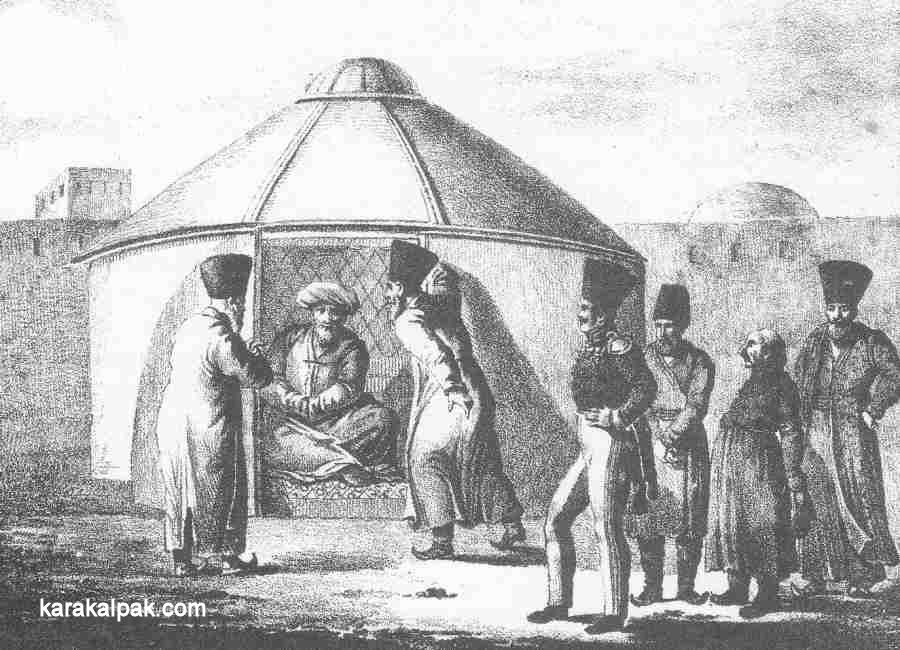
|
The tax archives of the Khivan Khan were collected by A. L. Kun in 1873 and were taken to Saint Petersburg only to be subsequently lost.
They were rediscovered and studied by Pavel Petrovich Ivanov in the 1930s. They show that during the 19th century there was an extremely
uneven distribution of wealth within Karakalpak society, which probably reached its peak sometime after 1850. Most peasants had insufficient
land to support themselves – plots of arable land were no more than one or two tanaps in size (1 tanap is equivalent to
0.4 hectare). However individual bays and religious leaders had hundreds if not thousands of tanaps of land – for example
the leader of the Qazayaqlı clan, Abdulla bay, had 6,370 tanaps. Livestock was distributed in a similar manner. Karakalpak
peasants could only survive by working for these landowners on a land-lease share-crop basis.
These terrible conditions were the cause of several Karakalpak revolts. One occurred in 1827-1828 in response to the collection of
cattle tax, the most widespread in 1855-1856, and a more localized revolt in 1860. The 1855 uprising was violently suppressed by
Sayyid Muhammad Khan and was followed by a major famine.
This explains why the majority of foreign visitors commented on the widespread poverty of the Karakalpaks throughout the 19th century.
More observant travellers realized there was a rich minority, although even their wealth was extremely modest by Western standards.
Russian reports on the Karakalpak encampments constantly referred to their terrible state of poverty and the generally poor condition
of the yurts.
The log of the Aral flotilla in 1848-1849 reported a visit to the Karakalpaks living in the lower reaches of the U'lken Darya:
"...these unhappy people, exhausted by labour and by deficiencies and oppressed by the clerks of the Khivan Khan, their decrepit clothing, hardly covered by rags – they represent the living picture of misery. Their nomad tents, covered with scraps of ragged felt, blackened from prolonged service, could hardly serve them as a reliable refuge from the intense heat and the cold."In 1842-3 the German naturalist Theodor Basiner observed the poverty of the Karakalpaks living on the left bank of the Laudan canal. The same Karakalpaks were involved in a major uprising thirteen years later.
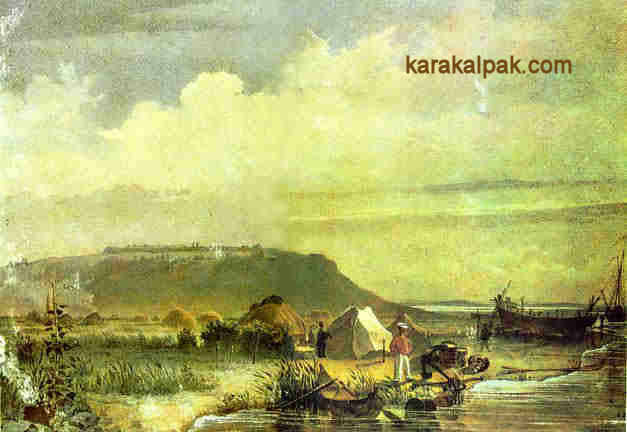
|
Arminius Vambery travelled across Central Asia in 1863 from Tehran to Herat. While in Khiva he travelled by boat down the Amu Darya to Qon'ırat, observing Karakalpak cattle grazing in the clearings between the woodland on the right bank. He wrote:
"The tent of the Karakalpaks is much larger, and of stronger construction than that of the rest of the nomadic tribes, and is guarded by a species of large dog, only to be met with among this tribe. In their dwellings in general they are distinct from the other nomadic tribes in dirt and uncleanliness; they evince also in their food and clothing a carelessness, which makes them abundantly ridiculed and disliked by their neighbours."Many other writers confirmed that the Karakalpaks were treated as underdogs by their larger and more dominant neighbouring tribes. Others commented on their widespread poverty, although there are occasional exceptions. The Ural Troops Gazette in 1868 mentioned the poverty of the general Karakalpak population and its oppression by Khiva. Kostenko mentioned their poverty and lack of development in 1871, while Saratov mentioned their overall poverty in his 1872 handbook.
"The framework of the kibitka, or Central Asian tent, is composed of a number of thin strips of wood six feet long, loosely fastened together in the form of a vine-trellis; this frame opens out and folds up compactly, so that it may be placed on a camel. The sticks forming this frame are slightly curved in the middle, so that upon opening out it naturally takes the form of a segment of a circle. Four of these frames complete the skeleton sides of the tent. On the top of this are placed some twenty-five or thirty rafters, curved to the proper shape, the upper ends of which are placed in a hoop, three or four feet in diameter, serving as a roof tree."MacGahan added that the whole operation took about ten minutes and that the kibitka was so solid that any wind other than a tornado would not budge it. Clearly the ownership of camels implies that these were wealthier Karakalpaks, and their yurts were furnished with carpets and "several soft, bright-coloured coverlets and cushions". Despite being cattle-breeders, they seemed to be following a Qazaq rather than a Karakalpak lifestyle, spending nine months of the year on the move, from spring to autumn, and living on milk, mutton, bread, and tea.
"As soon as the camel carrying the felt and framework of a kibitka arrived, he was made to kneeel down, two women seized the framework, set it up on end, and stretched it out in [the] form of a circle, one holding it while the other fastened the different parts together. Then the doorposts were set up, and a camel's-hair rope drawn around the whole, to bind it tightly together. One of them then took the wooden hoop, which serves as roof-tree, and elevated it inside the tent by means of a stick inserted in one of the many holes with which it is perforated, while the other immediately commenced inserting the rafters, some twenty or thirty in number, the bases of which are fastened to the lower framework by means of loops. The heavy rolls of felt are then drawn over this skeleton, and the kibitka is complete. ... "
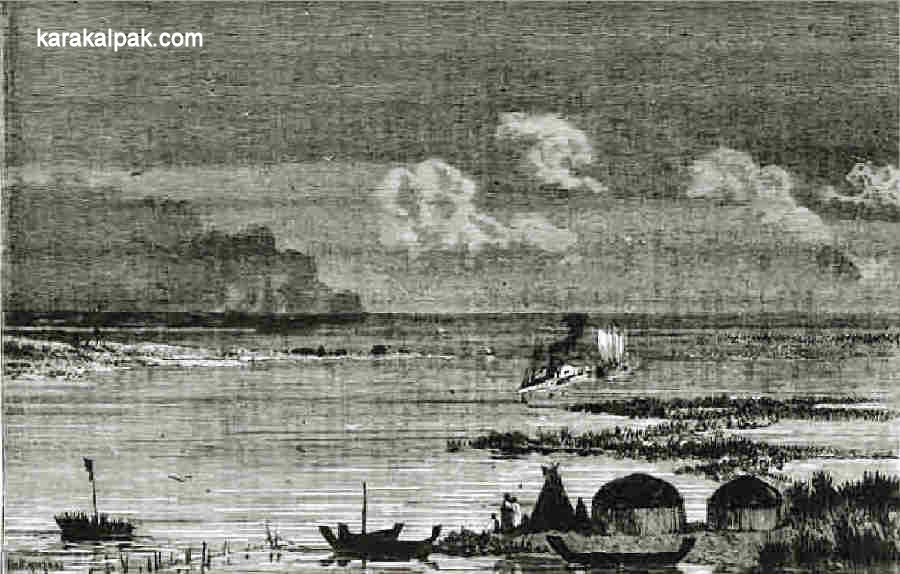
|
Sobolyev classified the Karakalpaks as settled rather than nomadic, since they only moved their yurts in the summer to the ploughed fields.
In the winter they gathered their yurts inside their qalas, in groups of several hundred, for protection against Yomut raids. He
estimated a total of 20,000 Karakalpak kibitkas. The overall poverty of the Karakalpak population meant that taxes were not always
paid to the Khivan Khan. However the Karakalpaks living along the Kegeyli River had very well-tended gardens and seemed to be better off.
Karazin's first views of the Aral Delta reminded him of the lower Syr Darya, even down to the coastal villages, although the kibitkas
of the Karakalpaks had different roofs and appeared flatter than those of the Qazaqs. One of the first Karakalpak villages he visited
was on the U'lken Darya in the middle of the delta. The yurts were arranged in disorderly groups and each was small, old, and
impregnated with smoke. Glancing into the first yurt they were overwhelmed by the stench of rotten fish:
"Complete misery reigned in this nomad tent. There was not one carpet, not even one felt – an essential belonging in every nomadic dwelling. Several bundles of reed were scattered on the bare earth and coals smouldered under the iron trivet. Some rags hung on a hair rope, which was used to expel the swarming parasites with the smoke ... We visited another nomad tent which was the same; in a third it was even worse!"Several days later they stopped at the first Karakalpak awıl on the road from Qusxanataw to Shımbay. It consisted of several impoverished and smoky yurts with felt roofs and shiy screen sides. Their wintering quarter was situated not far away – a quadrangular court enclosed by a high clay wall and with an overhanging roof along its internal sides. A shigir waterwheel irrigated their crop of cotton.
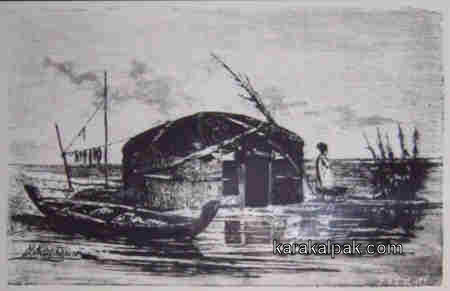
|
Small impoverished villages were also located along the Quwanısh jarma, just to the north-east of Fort No'kis. They were unkempt and
situated in the wild with kibitkas that were arranged higgledy-piggledy, as if the occupants had only arrived yesterday and were
ready to leave at a moments notice. The Karakalpak village of No'kis contained up to twenty kibitka clustered closely together only
the width of a foot apart. It was defended by ditches and a fence of thorny vegetation. Nearby were fields of cotton and ju'weri
(sorghum wheat).
Wood also observed the same Karakalpak settlements along the banks on the Kichkine channel, one of the mouths of the U'lken Darya.
They pastured cattle along the riverbanks and offshore islands, including Toqmaq Ata (which would later become the port of Moynaq),
and raised small quantities of cereals, storing their crops in mud-walled enclosures. The latter also afforded some shelter for their
kibitkas in winter. Further upstream the Karakalpaks had built small embankments to preserve their awıls from flooding.
Families in this region moved their kibitkas, household goods, and a few sheep and cows using small boats known as qayıqs.
He noted that the conditions of the Karakalpaks on the left bank had very much altered for the worse over the last eighteen years
following the deliberate closure of the Laudan canal in response to the 1855 uprising. In one stroke the Khan had deprived the
Yomuts of water, while flooding the pastures of the Karakalpaks.
"At the present day the Karakalpaks are among the poorest of the Turkestan races, and the occupation of the Amú district by Russia can scarcely fail to benefit them very materially."Another visitor at this time was A. V. Kaulbars, who noted some of the design features of the Karakalpak yurt, which was clearly distinguishable from the Qazaq yurt, even at a distance. The first indication was the shape of the roof:
"The frame of the Karakalpak roof is made from straight sticks that have been bent only at their lower end, so that they can be conveniently fastened to the wall, whereas the Kazakh roof is made of sticks that have been bent throughout their entire length into an arch. Therefore the Karakalpak roof takes the form of a cone whilst the Kazakh yurt has a spherical form. Secondly the Karakalpaks fasten the roof and the kerege lattice walls of their yurts with very wide white tapes, which intersect the roof in different directions, whereas the Kazakh roofs are either not completely fastened or else are fastened by narrow multi-coloured tapes."The floor of the Karakalpak yurt was generally covered with several old dirty and tattered felts. People even kept young lambs and kids inside their yurts, while rich Karakalpaks kept hawks or golden eagles trained to hunt. As protection from mosquitoes they fashioned bed-curtains from coarse material. Tradition demanded that all families had to leave the settlement in the summer, along with their yurts and other belongings, even though the distance of this migration might be no more than 500 metres.
"Approaching the Karakalpak village, located near the small estuary and only supplied with water from the Amu during high-water, we saw bustle; cries were heard from all sides; property and nomad tents were rapidly loaded onto arbas [Karakalpak two-wheeled carts], and everything which was ready was moved away in a hurry. Assuming that our unexpected appearance was the reason for this flight, we accelerated our step and sent our leaders ahead to quiet the population. It proved to be, however, that the reason for the bustle there was the rapid rise of water in the adjacent estuary, and before our eyes the place, occupied by the village, was flooded, so that arbas which were late were already being loaded by people standing in the water."A perceptive Russian assessment published in the Turkestan Gazette noted that, within the Amu Darya Division, the Karakalpaks lived exclusively in "nomad tents". In the northern Shımbay section there were 10,709 yurts and 4,553 houses, while in the southern Shoraxan section there were 800 yurts and 3,411 houses, indicating a clear divide between the tam-dwelling Uzbeks and the yurt-dwelling Karakalpaks and Qazaqs. Karakalpak poverty had become worse since moving into the Aral Delta, firstly because of taxation by the Khan, but also because of the collapse in their agricultural economy. Many irrigation canals had fallen into neglect, leaving some lands flooded and others waterless, especially near the coast. This was partly due to bad leadership among the Karakalpaks themselves but also because the Khan had frequently used obedient Karakalpak labourers to maintain the irrigation systems of the privileged Turkmen while neglecting their own.
"Karakalpaks are constantly located as in a state of siege and for their protection against the Turkmen are gathered into large villages which are guarded by clay walls."The constant threat of raids eased somewhat after the attachment of the lands to the east of the Amu Darya to Russia but did not go away – Russian occupying forces were simply inadequate to properly police the territory. However Lansdell gave some indication that by 1888 agricultural conditions were at last improving for the right bank Karakalpaks.
"The internal decoration of the nomad tent is very simple and depending on the means of the master consists either of felts, or of palas and carpets, with which they cover the floor and hang from the sides of the nomad tent. The tents of rich nomads are covered outside by the narrow woven strips, with which they affix the felt; in paupers the latter are usually fastened with camel ropes. Most nomad tents are occupied by the entire family, from small to large. Prosperous families have two to three nomad tents. However in the nomad tents of paupers one frequently finds young cattle in addition to the masters during the winter. On the whole there is inconceivable contamination both inside the nomad tent and outside, whose stench infects and dominates the air in the hot weather."Girshfeld and Galkin observed that the Karakalpaks were the minority compared to other nomads living on both banks of the oasis. The drying up of irrigation canals in the Shomanay region had forced 1,020 kibitkas (equivalent to 36% of Karakalpaks on the left bank) to abandon their settlements and to adopt a true nomadic lifestyle. Even so, the nomadic Karakalpaks still surrounded their kibitkas with reed or brushwood fences. They also noted that some of the wealthy Karakalpaks had started constructing mud houses enclosed with high mud walls, which they called a ha'wli - similar to the Uzbek hauli. However the owners of these houses still lived mostly in kibitkas, which were set in the middle of the gardens of their yards.
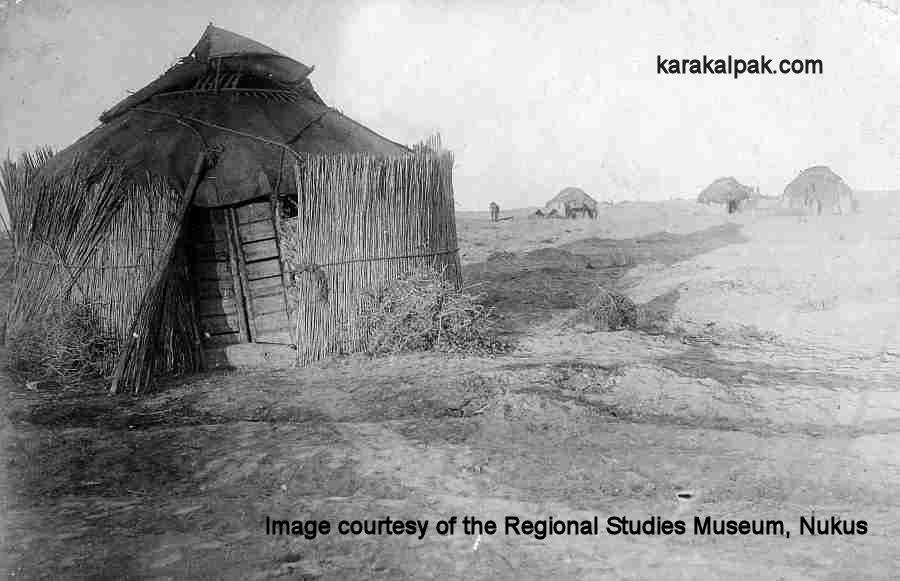
|
Karakalpak life continued much as before and Turkmen raids actually got worse after 1915 as the Turkmen rebel Junaid Khan ran
riot throughout Khorezm. In 1917 many Karakalpaks moved away from Shomanay towards Xojeli. We have met numerous old
Karakalpaks who can remember when they were children and were forced to hide in the fields during Turkmen raids on their
villages. This problem continued up to 1925.
In 1927 Anna Sergeyevna Morozova was contracted to write an ethnographical description of the Karakalpaks. Unfortunately
no record of this specific report remains, although Kurbanova did uncover another early compendium of essays which included a
chapter on dwellings. In the following year Aleksandr Lavrentevich Melkov led an expedition organized by the Society for
Research on Kazakhstan, aimed at documenting, photographing, and collecting items of Karakalpak material culture.
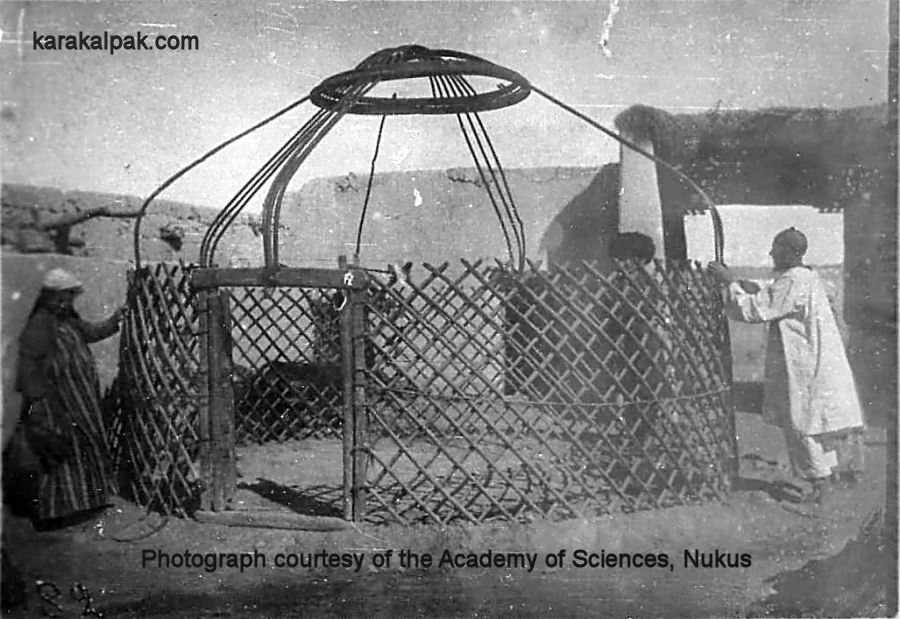
|
Many of Melkov's photographs concerned irrigation works, the local fishing industry, bazaars, and such like. However Melkov did
photograph a number of Karakalpak yurts in various conditions during his 1928 expedition: some decrepit, some very simple with no more
than a plain roof covered with scraps of felt and simple shiy screen sides, and some decorated with janbaw.
It is clear that Karakalpak yurts were still in widespread use at this time. A survey of handicraft enterprises operating within the
Karakalpak Autonomous Oblast in August 1927 identified 17 workshops making felts for yurts.
In June 1932 Lyman Wilbur from Boise Idaho, an American irrigation engineer contracted to the Soviet government, briefly visited the Aral Delta
and observed the dirty and disease-ridden towns of Qıpshaq and Xojeli. While sailing down the Kattagar canal to Shımbay he had
the opportunity to visit Karakalpak and Qazaq kibitki, which he described as reed and felt tents. Sailing north from Shımbay
into the delta towards the Aral port of Qanto'zek, Wilbur noted occasional kibitka in between the various delta channels, most likely
to have been Karakalpak given their position.
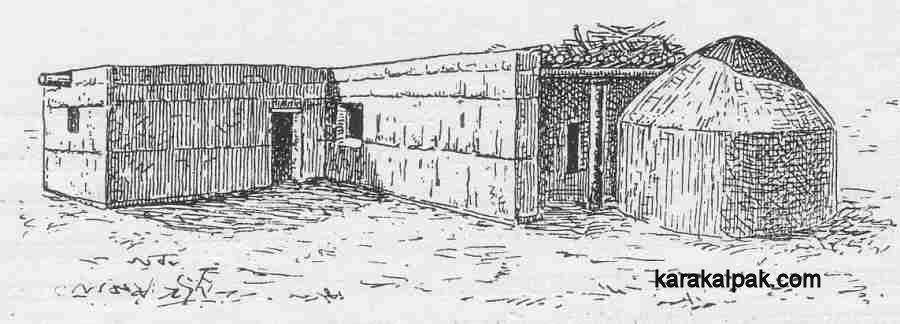
|
It was only after the forced collectivization of private farms in the early 1930s that the use of the yurt began to decline.
Collectives were eventually merged to create larger farms and new settlements began to be built for the agricultural workers.
Tams were laid out on a grid of roads, with perhaps a clinic, a school, or even a social club. Women were needed in the fields
to tend the cotton crop, or to work in factories, schools, and clinics. They no longer had time for weaving. It was not only
fashionable, but sometimes politically wise to value Western standards of dress and housing. Socially the yurt increasingly
became a recreational dwelling for relaxation and entertainment, erected during the summer months to provide a cool respite from
the heat of the day, especially when the reed screens were rolled back to let the fresh air blow through.
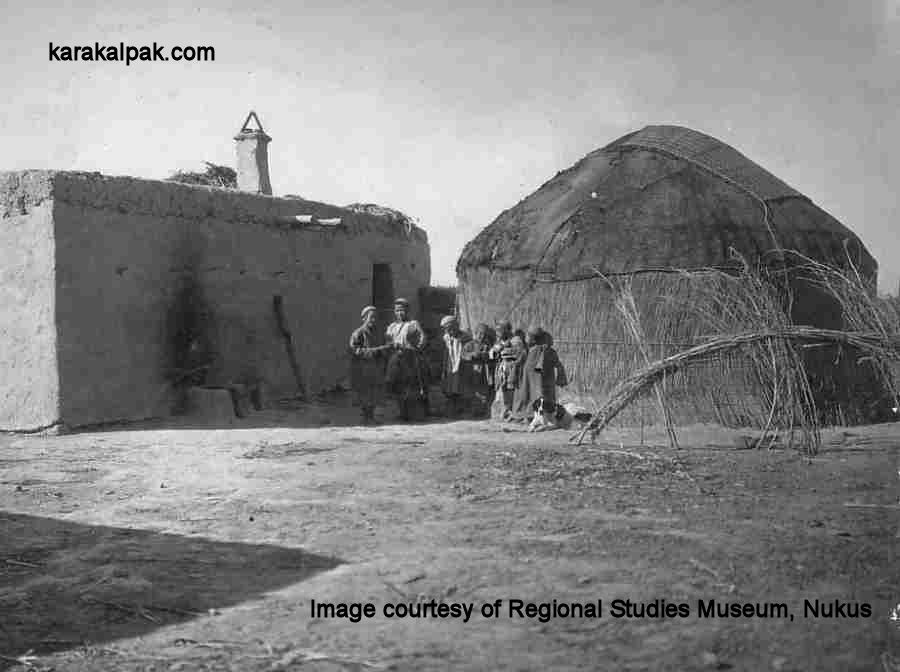
|
As life began to change irreversibly, so work commenced in earnest to record traditional Karakalpak material culture for posterity.
The Moscovite archaeologist Sergey Tolstov established the Khorezmian Archaeological and Ethnographical Expedition in 1937, but it
was not until after the Great Patriotic War that serious work could begin on the systematic collection of materials related to the
yurt. Even so, surprisingly little was published on Karakalpak yurts by his ethnographic colleague, Tatyana Zhdanko, in the early
works of the expedition. Zhdanko's most detailed decription related to the Karakalpak yurts used on the islands of the southern Aral
Sea in 1958. These were of a brand new small type, mainly produced by an artel (collective) in Shımbay, with the
kerege composed of five qanats and the roof supported by 85 uwıqs. On the islands the yurts were
positioned away from the damp shoreline and the loose sand. The local Mu'yten Karakalpaks prepared the ground by clearing a circular
area larger than the size of the yurt and putting down a layer of clay as a foundation for the yurt. Finally the perimeter of this
area was edged with a fence of plaited reeds to provide shelter from the prevailing wind.
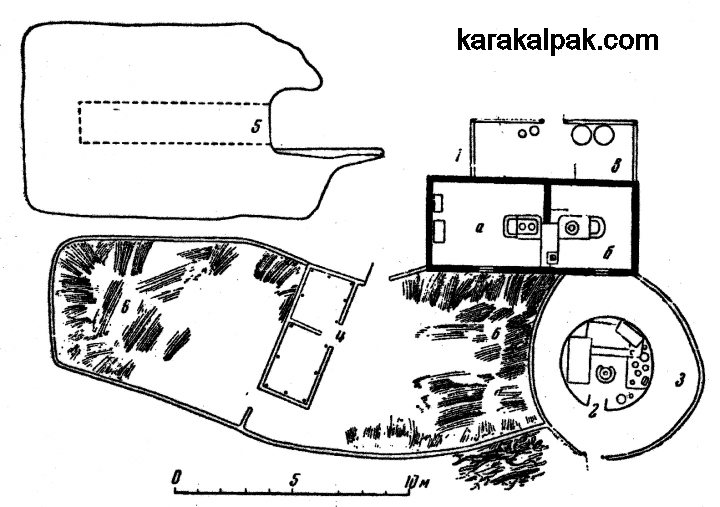
|
In the end it was left to Igor Savitsky, a Ukrainian painter, to acquire the most comprehensive collection of artefacts related to
the yurt with the help of Xojamet Esbergenov, the latter going on to publish the definitive description of the Karakalpak yurt in 1980.
Savitsky did publish a monograph on Karakalpak woodcarving in 1965, which covered yurt doors and wooden furniture.
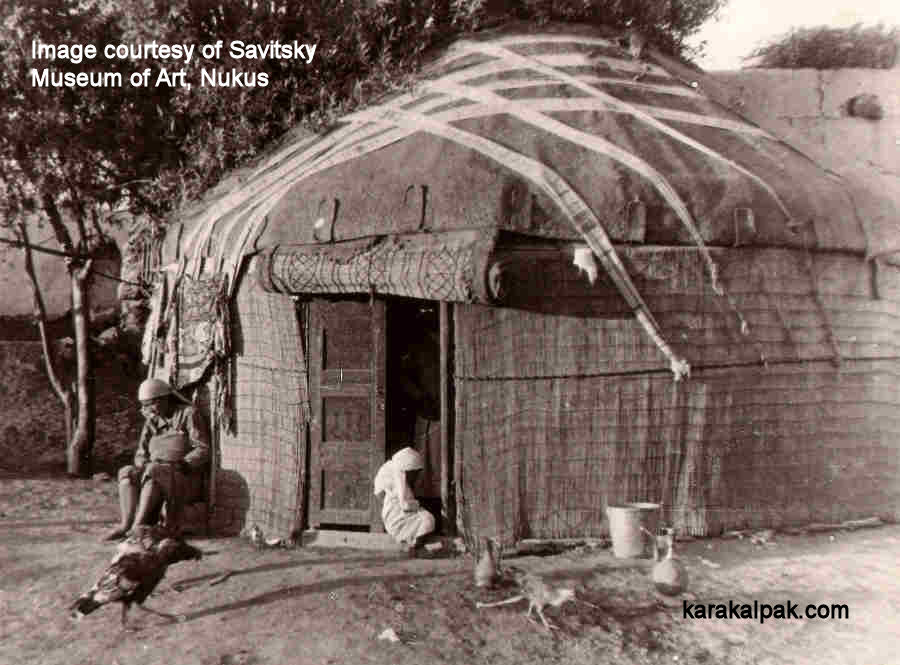
|
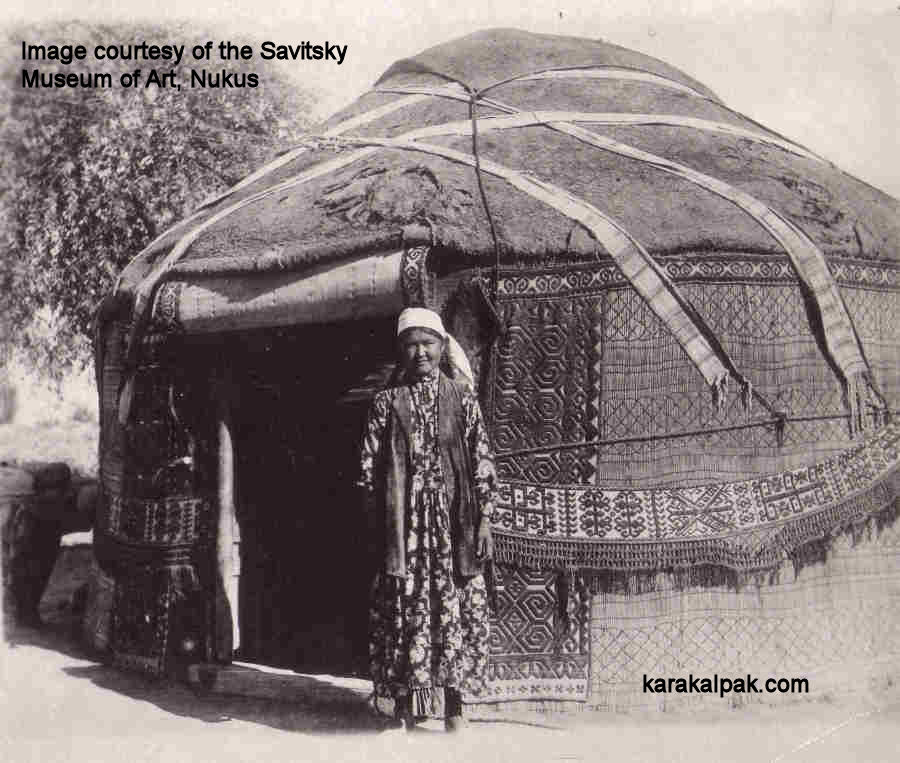
|
Today, whether in the suburbs of No'kis or in remote villages such as Qazaqdarya, yurts are still erected during the summer months,
either to provide a cooler sleeping place or a traditional venue for a celebration or for the entertainment of guests. However
in many families the younger generation have lost any interest in the old traditions. Frequently the tent bands have been sold for
some much needed cash or have deteriorated beyond use. We have even found situations where the yurt has been sold to someone in
Tashkent or the land that was reserved for erecting the yurt has been used for constructing a house for a son. For these and many
other reasons, the few Karakalpak yurts still in use continue to decline.
Pronunciation of Karakalpak Terms
To listen to a Karakalpak pronounce any of the following words just click on the one you wish to hear. Please note that the dotless letter
'i' (ı) is pronounced 'uh'.
 |
This site was first published on 6 July 2006. It was last updated on 7 March 2012. © David and Sue Richardson 2005 - 2015. Unless stated otherwise, all of the material on this website is the copyright of David and Sue Richardson. |